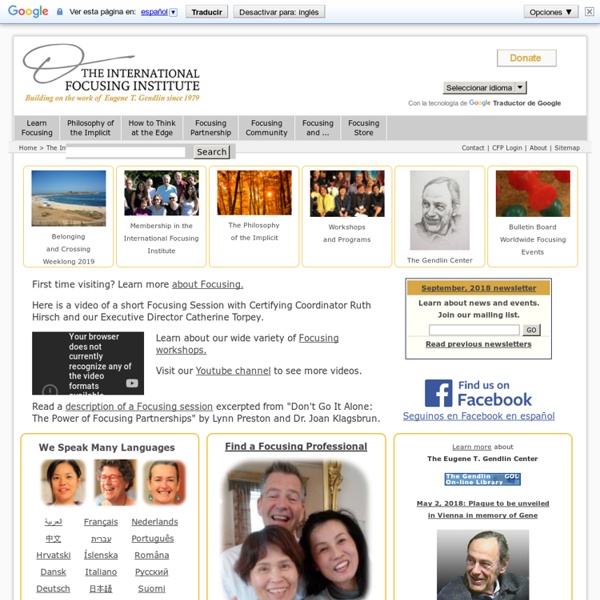



Solange Langenfeld Serranelli: Livres, Biographie, écrits, livres audio, Kindle Spiralis The Labyrinth Society: The Labyrinth Society Être la présence en action Welcome to the Labyrinthos Homepage Les activités de Focusing à Montréal et ailleurs Le Focusing est maintenant connu un peu partout dans le monde. Plusieurs universités enseignent des programmes en psychologie intégrant la pratique du Focusing. Plusieurs centres de formation indépendants offrent des crédits d’éducation continue (UEC) pour leurs programmes de formation à la certification. Le Focusing s’intègre de plus en plus à la pratique de la psychothérapie et à celle des thérapies de pleine conscience ou de travail corporel, à la massothérapie et autres approches de conscience corporelle telle l’approche Alexander, le Feldenkrais, la Méthode de Libération des Cuirasses (MLC) et autres. Il est enseigné au Québec, entre autres, dans les écoles de massothérapie offrant une formation dans les approches psycho corporelles en massage (massage californien, néo reichien, esalen, amma, etc.). Les activités de Focusing accessibles à tous Ateliers sur le Focusing et les rêves Gendlin a proposé une méthode de travail sur les rêves à partir du sens corporel.
EPG - Accueil - EPG Kahler Communication France En avons-nous toujours pleinement conscience ? Le succès de nos relations dépend de la qualité de notre communication.Les techniques et les outils pour mieux communiquer avec l’entourage professionnel et personnel sont nombreux et pourtant ils ne suffisent pas pour se mettre en phase rapidement avec des interlocuteurs aux personnalités très différentes. La Process Communication est un modèle immédiatement opérationnel qui permet de développer une communication efficace. Il prend en compte la spécificité de chacun et lui permet de donner le meilleur de lui-même, même dans les situations de conflits d’intérêt. La Process Communication® est connue, reconnue et utilisée dans le monde entier comme outil de communication et d’aide au management des entreprises. Développé en France depuis 1987 par Kahler Communication, le modèle est utilisé à ce jour par plus de 150 000 personnes en France, formés par un réseau de plus de 850 formateurs et coachs certifiés Kahler Communication France.
.: IGB - MRI :. Les contes de Grimm Jacob et Wilhelm GRIMM sont deux écrivains et érudits, nés à Hanau, Jacob le 4 janvier 1785 pour Jacob et le 24 février 1786 pour Wilhelm. Ils font leurs études à l'université de Marbourg. Jacob comme philologue, s'intéresse à la littérature médiévale et à la linguistique et Wilhelm comme critique littéraire. L'œuvre scientifique majeure de Jacob Grimm est sa Deutsche Grammatik (Grammaire allemande, 1819-1837), qui est généralement considérée comme le fondement de la philologie allemande. Les frères Grimm s'intéressent également aux contes populaires allemands. Hartman Value Profile - Robert S. Hartman Institute The science of formal axiology, developed by Robert S. Hartman, provides rational answers. Our values are the keys to our personalities, to self-knowledge, and to understanding others. Robert S. To complete the HVP, a person is asked to rank the items in Part 1 from best to worst and the phrases in Part 2 from most agree to least agree. The results of the HVP are derived from logical mathematical norms, and they are not based on the values of any specific population or group. The Hartman Value Profile is especially useful for the following purposes: The versions of the Hartman Value Profile given next are for information purposes only. Note with regard to the two above Hartmanian profiles that the Hartman Institute stands much more firmly behind the Standard HVP than behind the Research Edition because not as much validation work has been done on the Research Edition in its entirety. For information about Validation Studies, please click here. The Robert S.